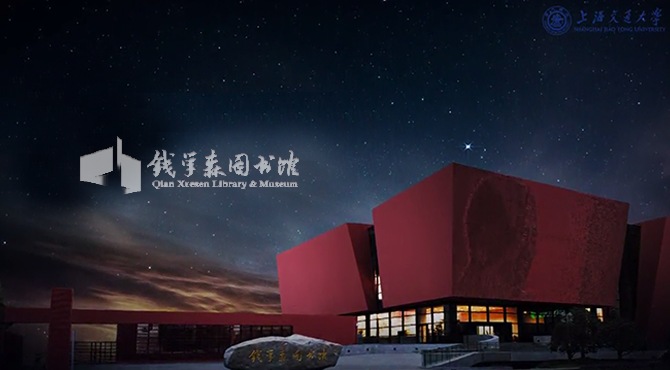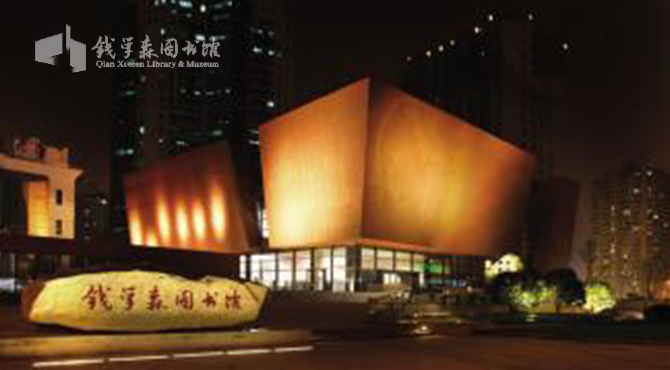Fan Xuji, the 37th President of Shanghai Jiao Tong University
[Preface] Mr. Qian Xuesen is a predecessor and a good friend of mine. In our school years, we had common goals and interests in music and photography; we were really intimate. This article is to commemorate our school years as well as our friendship after 16 years since his return to China.
Mr. Qian Xuesen is a predecessor of mine that I respected very much. Smart and learned, he was strict with himself and humble to others. He loved his motherland very much and devoted his life to serving the people. He's my idol as a scientist and a role model I should learn from.
In 1936, I got to know Qian Xuesen when we were both studying at California Institute of Technology in the US. Although we had the same mentor, Prof. T. von Karman, he was studying for PhD, while I was studying for Master Degree. I was majoring in structural mechanics and he was majoring in aerodynamics, so we were not very much related in our studies. However, we were still close because we lived together and had common interests.
As my Master's thesis was about photoelasticity, I needed to study photography and film developing. One of Qian's hobbies happened to be photography. Of course, I only asked for a clear photo without any specific techniques. However, Qian was a perfectionist in both art and technique. For example, he took various aspects such as time, distance, angle and view finding into consideration. In film developing, he had mastered many skills such as soft lens, zoom in, split joining and synthesizing. He had a photo of himself in a Doctoral gown. It was taken by himself after he had come back from the graduation ceremony, against a background also set up by himself.
Moreover, when I was in college at Harbin Institute of Technology co-established by China and Russia, I developed a hobby in western classical music due to the local social environment. Qian also had the same hobby. When we were in America, it was popular to go to cinemas and there were many cinemas in town. However, Qian never went for a film but for photography and concerts. There were some outdoor concerts in Hollywood in summer time and many master conductors came to perform on the concerts with their symphony orchestras. Although the concert venue was far away from where we lived and the transportation was inconvenient, Qian always went to the concerts in whatever means. In winter, when there were famous musicians coming to perform in chamber concert, he would also go to enjoy. So, photography and music became our shared hobbies during the four years of university time.
After receiving his PhD, he was hired by T. von. Karman as an assistant. In 1938, they co-authored an essay named The Boundary Layer of Compressible Fluid, and became famous since then. Later, Qian asked me, "What topic did Karman give you for your dissertation?" I was confused at first because his research had nothing to do with structural mechanics. After his explanation, I knew that he started to study the large deflection in the thin shell, which was interdisciplinary. It was the most cutting-edge field at that time and no one had done any research on it. He was the first one in the aerospace science department of California Institute of Technology to conduct such interdisciplinary research. It didn't happen out of coincidence but due to Prof. von Karman's recognition of talents and intention to develop a successor. The other time when we talked about the rocket weapons that Nazi Germany was developing, he said, "Goddard built a research house in the desert in Arizona and did the research behind the shut door. But we haven't seen him build anything or publish any articles or being interviewed. He's such a weirdo!" I realized that he was studying rockets. The range of his knowledge had been widening to all cutting-edge sectors in aviation science and finally reached aerospace. Even von Karman sighed that his student already excelled him and he said, "You're better than me now!" Unexpectedly, he became a lecturer of an institute named after Goddard in California Institute of Technology and the founder of the Jet Propulsion Research Center. However, he didn't shut himself in the lab but published many papers and solved the problem of sound barrier, paving the way for solving heat barrier problems.
Qian was quiet in the university because he always concentrated in thinking and spent very little time chatting. Even his close friends like Yin Hongzhang, Yuan Jialiu and Lu Jiaxi, dared not interrupt him. However, when he returned to China in 1948 and came to visit Zhejiang University where I taught, I found him very talkative with president Zhu Kezhen and other professors. He even talked to local villagers when he travelled to Mogan Mountain. He came back to China in 1955 to work in the Mechanics Department of Chinese Academy of Sciences. It rained on the last day of the establishment meeting of the Mechanics Department, so fewer people came to the meeting. Someone felt sorry about it but Qian added, "Now our country is in urgent need of regeneration and everyone is busy in the construction. Soon our country will have a brand new look and it was very exciting. We mechanics expert should play our part to make contribution to our country" (general meaning). His words greatly aroused people's passion and I had a new understanding of him. He is actually an eloquent person and his words can be inspiring. It's not his personality to be quiet and not willing to communicate with others. He just needs to concentrate on his study and research.
Qian has a strong sense of forward looking and planning. For every decision, he must have been deliberating for sure and then came up with a plan for execution later. I can see that from his lecture notes, which are tidy and neat. Even the charts and graphics are clear and specific, just like in a textbook. It's hard to imagine that he wrote the notes himself. He must have mastered everything in the content and then wrote in a smooth manner. Otherwise, it's hard to imagine how long it should take to complete such a wonderful lecture. Moreover, every piece of his lecture was written in this way. Qian's careful planning and rigorous working style was not only shown at work but also in his life, for example, his wedding. He planned his wedding in a very considerate way and the wedding conformed to no conventional pattern but still festive. It was the most unforgettable wedding I ever attended. He wrote to me a letter before the wedding and said, "As long as you make a good arrangement before you come to Shanghai for my wedding, it won't affect your work.” Everything went on as planned and in time, just as he planned. Everyone knows it's important to make plans in advance, but his plans were always extraordinary because of his wisdom, diligence and concentration. Being strict with one's own behavior is a traditional virtue in China but it's difficult to keep it. However, Qian did it. It is also why the aerospace industry of China can be so successful in developing new spacecraft.
The most unforgettable experience was an academic cooperation with Qian. In 1958, China Academy of Sciences proposed a motto of "enhancing discipline construction by completing missions". As a response to the motto, I proposed a scheme to develop a small, unmanned plane at the former Nanjing University of Aeronautics and Astronautics. At that time, the university was in the process of transforming from college to university and the success in the project could enhance the education and research level. As the majority teachers in the university had just came back from study or work in overseas aerospace universities and factories and felt lack of opportunity to use their knowledge, the proposal soon received supports from teachers. After getting the approval from my superior office, I asked for advice from Qian who worked in the former No.5 Institute of the Ministry of National Defense. Qian said, "Lucky you're here. We're developing a model and need a drone aircraft. Your unmanned plane project can be integrated into our project." After then, we started an eight-year cooperative research. During our cooperation, I went to Beijing to ask him for advice for many times. With his support and help, we were able to build some large facilities for scientific research, such as high and low speed wind tunnel and simulated flight platform. Our university became another base to develop unmanned planes. Via this mission, we also established some new majors such as wireless electric control remote telemetering, radar, radio navigation and computer, which trained a large number of talents for the country to support the development of aviation and aerospace industry.
Mr. Qian had an extensive range of knowledge and always followed up the development of multiple disciplines. After the Cultural Revolution, I was transferred to Shanghai Jiao Tong University. In 1983, Mr. Qian was invited to Shanghai Jiao Tong University for a teachers' seminar, in which he answered some questions related to education and scientific research and it was very helpful for us. Before he left, he went out of the office building and stood in front of the library of his alma mater for a long time. In 1985, I paid a visit to some universities in North America and signed a cooperation program for computer aided production workshop. Guangming Daily had a brief report on the new major. Seeing the report, Mr. Qian wrote me a letter immediately to ask how it was going on. The other time, the Biological Technology Research Institute of Shanghai Jiao Tong University led by Prof. Zhu Zhangyu published an article called The Dawn of Ecological Agriculture, which introduced the development of biological technology in Shanghai Jiao Tong University. Mr. Qian was very interested in the subject and asked me for more details. Then he had a meeting with Prof. Zhu Zhangyu. In early 1990s, I went to Beijing for a business trip and visited Mr. Qian who was hospitalized in 301 General Hospital. He didn't have any serious health problems and was still talkative. He mentioned human's thinking development and artificiality. In late 1990s, his health was even worse. When I went to visit him, we still talked about desert engineering. I suggested that he take a walk as often as possible and he only smiled. I could see that it was already difficult for him to walk but he was still concerned about the big news in the country and the development of science in China. He was still trying to find solutions for the problems in the country.
The last time I saw Qian was the day after his birthday in 2007. Qian had been confined to bed for many days. Though he had difficulty speaking, his mind remained clear. I mentioned the construction of the new campus of Shanghai Jiao Tong University, Qian's alma mater and asked if he still remembered the old campus. He thought for a while and showed me with his hand gesture that the library was on the right of the campus entrance. I'm sure he spent a lot of time in the library because he remembered it so clearly and still missed it. The Qian Xuesen Library & Museum under construction now is located immediately to the right front of the old library of Shanghai Jiao Tong University. If Qian knew about it, he would be happy. After the opening of Qian Xuesen Library & Museum, people, especially teenagers will have opportunities to know about Qian Xuesen as well as his glorious life, together with his hard work. The patriotic and scientific education in the library can encourage the youths to keep innovating in their study and work, making contributions for the development of the country, people's happiness and welfare as well as scientific progress.
People's great scientist Qian Xuesen will be immortal!
(Published in Spaceflight Engineering, 05 issue of 2011)



